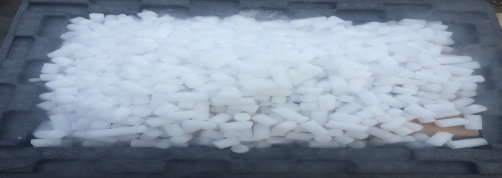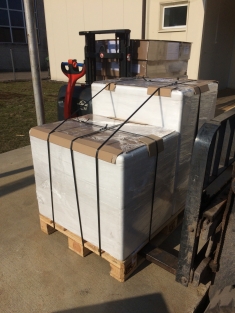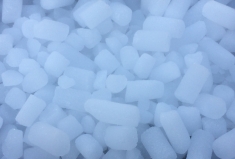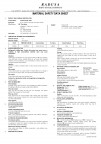|
Products » Material safety data sheet
|
MATERIAL SAFETY DATA SHEET
1. PRODUCT AND COMPANY IDENTIFICATION
Product Name:
Carbon dioxide, solid
Synonyms:
dry ice; carbonic acid cold; solid carbon dioxide
Manufacturer:
JSC Gaschema, Jonalaukio k., Ruklos sen., Jonavos r., Lithuania.
Tel.: +370 349 56 465. Fax: +370 349 56 465
Information:
+370 349 56 636; +370 349 56 736
Supplier:
Radusa, UAB, Kestučio 30A, LT-08112, Vilnius, Lithuania
Tel.: +370 611 45162, +370 687 33347
2. COMPOSITION / INFORMATION ON INGREDIENTS
Molecular formula: CO2
Molecular weight: 44.011gmol-1:
CAS#: 124-38-9
EINECS#, ELINCS#: 204-696-9
Chemical Name: Carbon Dioxide
% Volume: > 99.96
Hazard Symbols: None
Risk Frases: None
3.HAZARDS IDENTIFICATION
Refrigerated solidified gas. Contact with product may cause burns or frostbites. In high concentrations sublimed vapor may cause asphyxiation.
Inhalation
Inhaling high concentrations can cause rapid circulatory insufficiency leading to coma and death. Chronic, harmful effects are not known from repeated inhalation of low concentrations. Low concentrations of carbon dioxide cause increased respiration and headache.
Ingestion
Ingestion is unlikely. Accidental intake of carbon dioxide (solid) may cause frostbite.
Skin contact
Contact with product may cause frostbite. Frostbite effects are a change in color of the skin to gray or white. Skin may become inflamed and painful.
Eye contact
Contact with product may cause cryogenic burns.
Evidence for reproductive toxicity, carcinogenicity and mutagenicity
No data available.
4.FIRST AID MEASURES
After inhalation
If inhaled, remove victim to fresh air. If not breathing, give artificial respiration. If breathing is difficult, give oxygen and get medical attention.
After skin contact
Wash skin with cold water and soap and rinse thoroughly. Get medical attention if the cryogenic burn has resulted.
After eye contact
Rinse opened eyes for several minutes under running water. Get medical attention if eyes become irritating. If the victim cannot tolerate light, protect eyes with a light bandage.
After ingestion
Get prompt medical attention.
5.FIRE FIGHTING MEASURES
Fire and explosion hazards
Not flammable.
Suitable extinguishing media
All known extinguishing media can be used.
Protective equipment
Wear in fire self-contained breathing apparatus and protective clothing to prevent contact with skin and eyes.
6.ACCIDENTAL RELEASE MEASURES
Personal precautions
Avoid contact with spilled product. Use proper personal protective equipment as indicated in Section 8. If spilled in confined area, provide ventilation to prevent buildup of carbon dioxide gas.
Measures for cleaning / collecting
Allow spilled solid product to sublime (evaporate) in well-ventilated area. Provide ventilation.
7.HANDLING AND STORAGE
Handling
Avoid contact with eyes and skin.
Storage
Store carbon dioxide (solid) in insulated containers, which open from the top equipped with loose fitting lids, which will allow escape of vapor due to sublimation.
Vapor of carbon dioxide is heavier than air and may accumulate in confined spaces, particularly at or below ground level.
Use only in well-ventilated places.
DO NOT PUT DRY ICE IN A CLOSED CONTAINER WHERE EVOLVED GAS CANNOT ESCAPE!
8.EXPOSURE CONTROLS / PERSONAL PROTECTION
Eye protection
Safety goggles (glasses) or face shields.
Skin protection
Insulated gloves.
Hygiene measures
Keep away from foodstuffs and beverages.
Avoid contact with the eyes and skin.
Do not eat, drink or smoke while working with products.
Breathing equipment
Not required.
Exposure limits:
TLV (ACGIH), 5000ppm
MAK-Wert (Germany)5000ppm STEL (UK)15000ppm
LTEL (UK)15000ppm
9.PHYSICAL AND CHEMICAL PROPERTIES
Melting point: -56.6°C
Boiling point: -78.5°C
Critical temperature: 30°C
Relative density, gas:1.52 (air=1)
Relative density, solid:1.87 (water=1)
Vapor Pressure 20°C:57.3 bar
10.STABILITY AND REACTIVITY
Stability
Stable at atmospheric pressure and -78°C. At normal temperatures product ublimes into carbon dioxide gas.
11. TOXICOLOGICAL INFORMATION
General
High concentrations of sublimed vapor cause rapid circulatory insufficiency. Symptoms are headache, nausea and vomiting, which may lead to unconsciousness.
12. ECOLOGICAL INFORMATION
No data available.
13.DISPOSAL CONSIDERATIONS
Allow to sublime (evaporate) in well-ventilated area.
14.TRANSPORT INFORMATION
UN 1845, Hazard class 9 (miscellaneous).
15.REGULATORY INFORMATION
R22 Harmful if swallowed. R36 Irritating to eyes. R38 Irritating to skin.
S36/37/39 Wear suitable protective clothing, gloves and eye/face protection. R9 Keep container in well-ventilated place.
16.OTHER INFORMATION
This information is based on our present knowledge and shall be used only as a guide. However, this shall not constitute a guarantee for any specific product features. UAB Radusa is not held liable for any damage resulting from handling or from contact with the above products.
MSDS has been prepared in accordance with EU Directive 67/548/EEC, 91/155/EEC and other EU Community legislations in force.
Updated 10.2018







